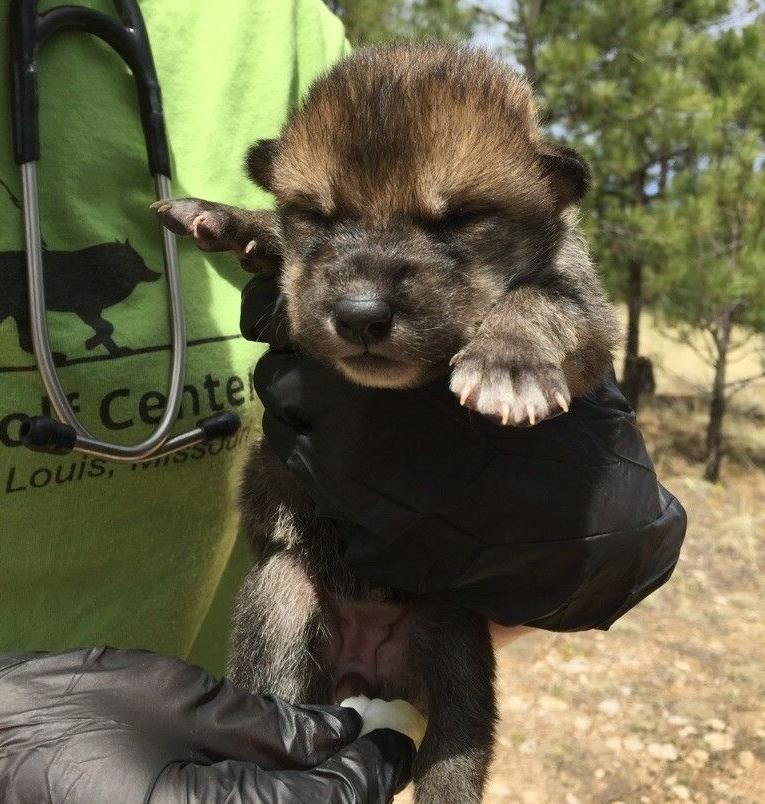With 9-day-old pups tucked
securely in a special backpack, Regina Mossotti hiked into the mountains
in New Mexico to say goodbye to the newborns who were about to make
history — and possibly a difference in the survival of their critically
endangered species.
The Mexican wolves, born April 15 at the Endangered Wolf Center
in Eureka, had flown with Mossotti and another helper more than 1,000
miles for their mission. The wolves, named Vida and Lindbergh, represent
hope for a species with fewer than 100 individuals left in the wild.
The
mission: Take the pups from their biological mother and siblings from
their home in captivity in Eureka and “cross-foster” them with a
surrogate mother in the wild who had given birth around the same time.
Cross-fostering can help the Mexican wolves survive by
increasing the genetic diversity of the wild population. The 9-day-old
Mexican wolf pups were moved from the more genetically diverse captive
population and will contribute to the gene diversity of the wild
population if they survive to become breeding adults.
But
for it to work, there was a lot that had to line up. Placing
captive-born pups into wild dens had never been tried before with
Mexican wolves.
First, there was the timing. The wild and
captive litters need to be born around the same time, and the transfer
of pups from captivity to the wild has to occur before the pups are 10
days old, experts say. This makes the transfer easier for the pups, who
still have their eyes closed and, much like other newborns, spend most
of their time sleeping and eating. Then, there were the logistics. The
wild den location needs to be known, a flight needs to be scheduled and
weather conditions should be perfect.
The Endangered Wolf
Center worked with the U.S. Fish and Wildlife Service on the effort. In
New Mexico, a female wolf that was tracked with a GPS collar had
stopped roaming like wolves do most of the time, and was staying in one
location and then disappeared — a good indicator that she had gone down
into the den and the satellite signal was no longer working. This was a
clue to the Fish and Wildlife Service that she had given birth.
Mossotti
and Emma Miller, an animal keeper at the center in Eureka, flew
commercially to New Mexico with Vida and Lindbergh. They drove a few
hours to Catron County and hiked about a mile and a half, where they met
Fish and Wildlife staff to hand over the pups. The staff then hiked
about another mile and half to the den to place the pups. During the
trip, they fed the puppies formula.
But would their surrogate mother wolf accept them?
Placing the pups
When
staff got close to the den, the mother wolf ran away. That she left her
litter shows how scared of humans wolves are, said Mossotti. The mother
stayed close, though, about 100 meters away, while the staff went to
work.
In the den, they found five puppies. The goal was
to help disguise the new puppies as the mom’s own as quickly as
possible. The puppies’ escorts wore gloves the entire time they were
handled to avoid transmitting unfamiliar scents. They rubbed dirt on
Lindbergh and Vida, and rubbed them with their new siblings, as well as
their urine, to transfer scents.
And then the staff left.
Within the hour, Lindbergh’s and Vida’s surrogate mother returned to her den. And she has stayed in the area since.
At this point, conservationists consider it a successful cross-fostering.
“Wolves
are very nurturing,” Mossotti said. “They have this instinct to take
care of these puppies. Fish and Wildlife Service did a great job of
making sure those pups blend in with her litter.”
Wildlife
staff are supplementing the pack’s natural diet by giving them elk that
have been hit by cars. That supplemental food will help the foster
parents take care of their new, larger litter of seven.
Once declared extinct in the wild
This could be a key point in saving the Mexican wolf,
which had been hunted to the point where they were declared extinct in
the wild in 1980.
The first release of Mexican wolves
back in the wild took place in March 1998, with nine of the 11 wolves
released coming from the Endangered Wolf Center.
The past
releases were of adult wolves. While those born in captivity do well,
those raised and taught to survive in the wild by a mother and father
who already have a pack established have much better chances, Mossotti
said.
A spokesman for the U.S. Fish and Wildlife Service in New Mexico called Lindbergh’s and Vida’s placement in the wild historic.
The
service began using cross-fostering with other species as a management
tool in 2014 in an effort to increase the gene diversity of the wild
population.
Mossotti said getting the pups from a den in
St. Louis to a den in New Mexico successfully was nothing short of
exhilarating — and exhausting.
As for Lindbergh’s and Vida’s biological mom, she has taken the adoption of two of her babies well.
“She
handled it great. She went back and cared for the (remaining) pups she
had. She didn’t look stressed. She looked calm,” Mossotti said. “We know
it’s such a vital need for the species to survive. It’s not an easy
thing to do, but it’s so important.”
Lindbergh’s and Vida’s biological siblings soon will be available for viewing on the Endangered Wolf Center’s live web cam at www.endangeredwolfcenter.org/webcams.



No comments:
Post a Comment